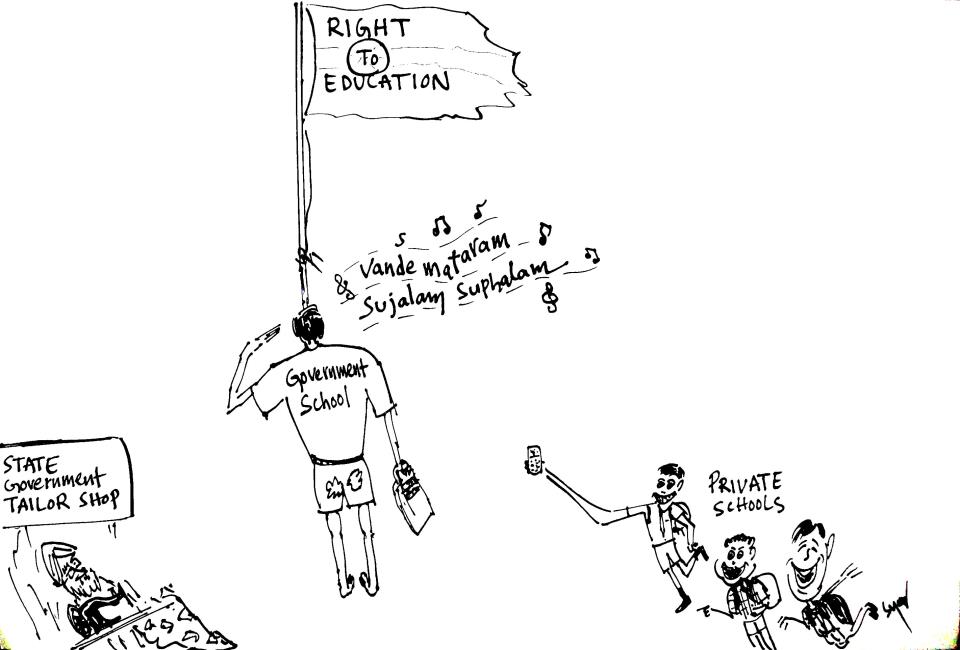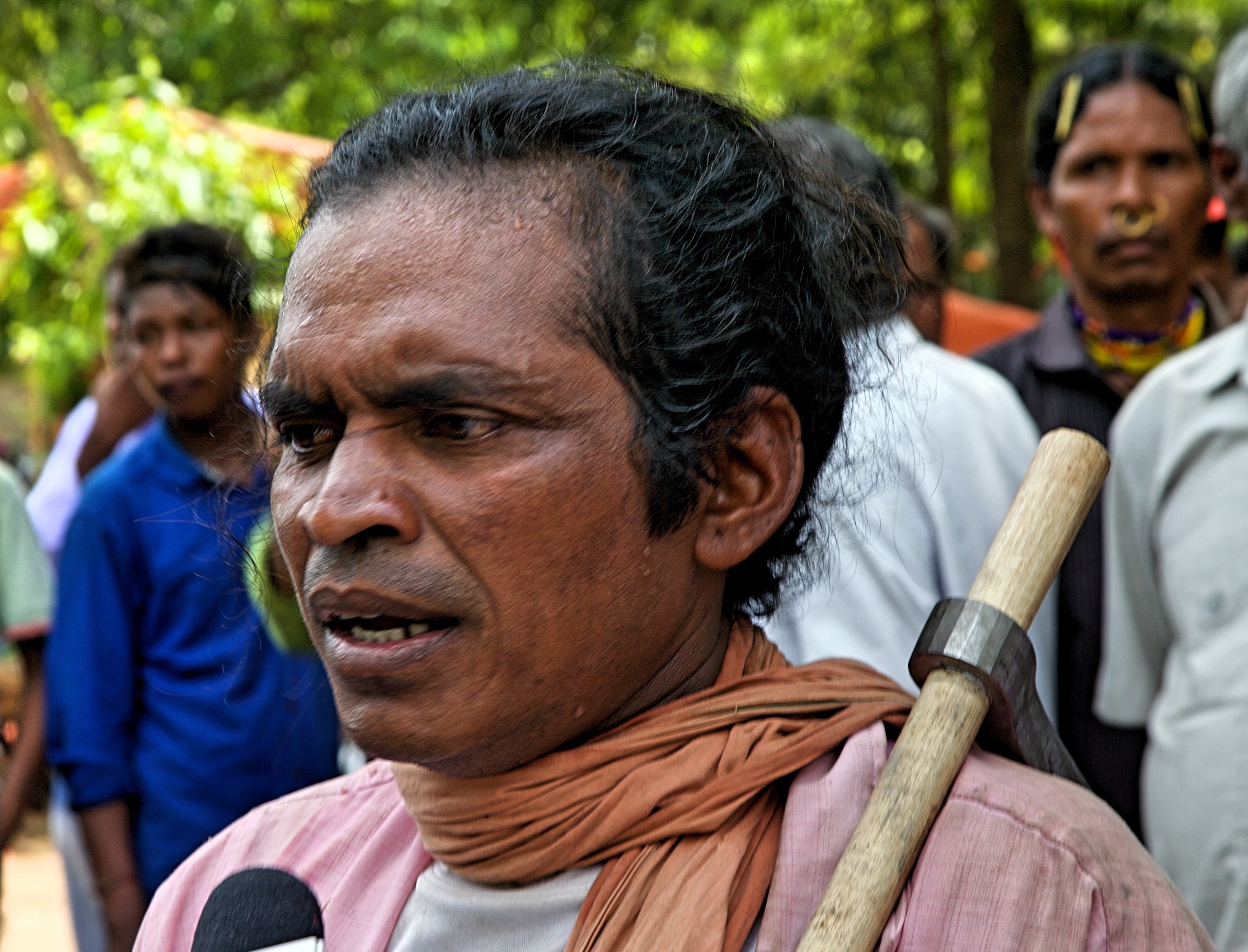Kuffir
My grandfather,
The starvation death
Which occurred during the drought when men were sold;
My father,
The migrant life
Which left home in search of work to pay off debt;
I, in ragged shirt and shorts,
The salute to the flag hoisted in school.*

This year marks the 100th anniversary of the Russian Revolution. It’s been over 25 years since the formal dissolution of the Soviet Union. Babasaheb was proved right: Can you have economic reform without first bringing about a reform of the social order? (Annihilation of Caste)
And the Indian state turned 70 yesterday. Babasaheb had warned political reform would be meaningless without social and economic reform. And he has been proven right again. Even political democracy has not been translated into a substantive reality; Mayawati’s angry exit from parliament is the starkest pointer in recent times. In fact, since the seventies, political freedom has become an even thinner proposition.
So what do the Bahujans have now? Neither real political freedom nor any social and economic independence.
There used to be an old English phrase, ‘three scores and ten’, which was supposed to indicate the life span of a man: 70 years. Isn’t it time we gave up some old delusions about the Indian state? Lots of beliefs have died in the last 70 years. It’s time for the Bahujans to seriously retrospect. The old India is dead. Do we want a new India?
The objective of a society of equals – in economic, social, political terms – which the Marxists called a socialist society and which the Russian Revolution sought to achieve still remains a noble ideal, and Babasaheb’s own belief in that goal speaks through his various important works. What he differed with was what he called the Marxian Creed (Buddha or Marx):
The Marxian Creed was propounded sometime in the middle of the nineteenth century. Since then it has been subjected to much criticism. As a result of this criticism, much of the ideological structure raised by Karl Marx has broken to pieces. There is hardly any doubt that Marxist claim that his socialism was inevitable has been completely disproved. The dictatorship of the Proletariat was first established in 1917 in one country after a period of something like seventy years after the publication of his Das Capital the gospel of socialism. Even when the Communism—which is another name for the dictatorship of the Proletariat—came to Russia, it did not come as something inevitable without any kind of human effort. There was a revolution and much deliberate planning had to be done with a lot of violence and bloodshed, before it could step into Russia. The rest of the world is still waiting for coming of the Proletarian Dictatorship. Apart from this general falsification of the Marxian thesis that Socialism is inevitable, many of the other propositions stated in the lists have also been demolished both by logic as well as by experience. Nobody now accepts the economic interpretation of history as the only explanation of history.
It wasn’t just the Marxists who were obsessed with the economic interpretation of history: the liberals too have always promoted the march of capital in the name of standing for individual freedoms and democracy. The fall of the Soviet Union has emboldened these status-quoists even more.
Across the world now, what passes for liberation and democracy is mostly a very problematic, sometimes Euro-centric but mostly American interpretation of an equalitarian society and this has been ravaging third world nations, ruining their societies and economies. It has brought with it several disingenuous narratives and discourses, to distort understandings of class and its correlation with caste and race. It turned very obvious contradictions in various societies into ambiguous sermons on privileges and deprivations. This article is an attempt to take a look at the more concrete realities of India, over the smog of orchestrated, liberal noises.
A couple of months ago, it was that season again: when Oxfam, Credit Suisse and other international agencies start swamping the media with dramatic nuggets of information about how disproportionate a share of the world’s wealth the top 1% of the world’s population holds etc. Brahmin-Savarna media in India borrow or often misappropriate/misinterpret the data to tell you how the top 1% of Indians hold 58% of the country’s wealth, the top 10% own 80% and so on. They never tell you about the caste of this top 1% or top 10% or 30%. Or of the bottom 50% or 70% or 80%.
It is obvious to all that the top 10% or 20% are almost exclusively Brahmin-Savarnas, and that the bottom 70% or 80% are almost exclusively Bahujan. But the Brahmin-Savarnas don’t see it that way: their goal is economic independence from the top 1% who own capitalist means of production while the Bahujans want political, social and economic independence from the top 20%, which includes the Brahmin-Savarna ‘revolutionaries’ and liberals.
This is where the Brahmin-Savarna project of obfuscation begins: they study Indian society in the same way as one would look at liberal democracies in the west where capitalist mode of production predominates, ignoring vast evidence to the contrary that says it is caste that is the dominant mode of production in India.1
Employing the orthodox Marxist economic interpretation of history, they pontificate that the ownership of means of production alone divides society into classes in India too – this neatly brings in all the Brahmin-Savarnas who don’t own capitalist means of production, but do own huge chunks of agricultural land and urban property, uninterrupted benefits from state institutions through employment in the government and public sector, for generations, and undisputed monopoly hold over industry, trade and even the ‘development’ or the NGO sector, into the broad class of the oppressed. Even as their control over both political and civil societies, apart from their rights over the state and capital, grow deeper and comprehensive.
Even without any fundamental right to private property, the Brahmin-Savarnas seem to enjoy unfettered right to ownership over most of the property, movable and immovable2; while the Indian Constitution speaks against caste-based politics, the Brahmin-Savarnas have never faced any major hindrances in over-occupying all the elected offices in the land, from panchayats to parliament, signifying there is no fall in their traditional social status; and whether under the ‘socialism’ of the early decades, or the liberalized economy of the last three decades, the growth in their wealth and entitlements hasn’t shrunk even a bit.
The concerns of European/American democracies and the Indian experiment in democracy are therefore quite different. The concerns of the Brahmin-Savarnas and the Bahujans are even more radically different.
As old India dies, shouldn’t the primary criterion to define classes in India, at least now, be recognized as control over the reins of production rather than just ownership of means of production? Because the orthodox Brahmin Marxist formula, which allowed the most orthodox Brahmins to lead and define ‘revolutionary’ struggles seems more and more farcical by the day. From Sitaram Yechury to Kanhaiya Kumar, even as their political freedoms seem to be sometimes curtailed, their social and economic freedoms are never affected much. As is the case of Mohan Bhagwat and Narendra Modi, or Sonia Gandhi and Arvind Kejriwal.
But it’s not the same for the Bahujans: they’ve to fight for political, social and economic freedoms all the time, simultaneously. They’ve to fight not just the top 1%, but all of the top 20% for their independence.
Babasaheb had unmasked the face of the enemy, calling it the governing class in India, and identifying it as the Brahmins (What Congress and Gandhi have done to the Untouchables: A Plea to the Foreigner) and said:
For whose freedom is the Congress fighting? Is it fighting for the freedom of the governing class in India or is it fighting for the freedom of the people of India?
Remember, the Congress represented all Brahmin-Savarna forms of politics back then – from the Hindu right to the Hindu left plus the vast centre. Now the governing class has expanded by including all the collaborating, land and wealth owning upper castes, but its character remains the same. But it still fights for the same caste-less freedoms.
Caste determines your place in the political economy, to a substantive extent: this is the concrete aspect of caste that almost all discussions around it ignore. When the Brahmin-Savarna Marxists say, Babasaheb had identified Brahminism and Capitalism as twin enemies, and therefore they share common goals with the Bahujans, they’re being deceptive. They believe capitalism and brahminism are two separate entities and not a single, fused overarching reality, where the former process is only used, in a calibrated fashion, to preserve the social order proposed historically by the latter. The Brahmin Marxists’ formulations rest on the fallacious assumption that Brahminism had/has an autonomous existence, without being anchored in any concrete social reality. The following section shall attempt to make this flawed thinking plainer.
~
Bhagat Singh said: However ultimately the problem cannot be satisfactorily solved unless and until untouchable community themselves unite and organize.
So he turns the ‘Hindu problem’, as Babasaheb said, into a Dalit problem again. It becomes a mere cultural problem. That has been the view of most Marxist thinkers in India for over a century.
Babasaheb had said, in a message to the first issue of Gandhi’s Harijan in February 1933 (Dhananjay Keer): The outcaste is a by-product of the caste system. There will be outcastes as long as there are castes. Nothing can emancipate the outcaste except the destruction of the caste system.
The contradiction between what he says and Bhagat Singh’s views can be seen clearly. For a Marxist, Bhagat Singh employs very speculative reasoning: how can the outcaste or by-product clean up the whole polluting process of production of castes? Whereas Babasaheb nails the problem with accuracy.
Marxists should have seen the production of castes as the production of conditions that sustain castes and outcastes (because, even as Hindu or Indian society, to be precise, excluded the outcastes, its political economy never rejected their labour). And as the crux of India’s political economy, even as it seemingly, but not in reality, went through changes in modes of production.
This is the reality that they contributed to producing — if you read closely, the data that the Brahmin-savarna media is spewing, and make your own calculations, this is what you’ll find:
If 57 rich individuals own wealth equal to what the bottom 70% of Indians own, it means 91 crore Indians, or the bottom 70%, own $216 billions, which amounts to roughly a 1/14th or 1/15th share in national wealth (or 7%-6%). Another bit of data tells you that the top 10% own over 80% all national wealth. A little more math tells you that the top 30% own 93-94% of all national wealth. What do the top 20% own? Nearly 90% of all wealth, perhaps.3
Why all this confusing number-play to hide the fact that the Brahmin-savarna, upper castes own over 90% of India’s wealth? Shouldn’t this lay to rest all assumptions that caste or Brahminism doesn’t have any concrete foundations in the political economy?
Let’s look at some other interesting facts. Among other things, the United States of America consumes 24% of the world’s energy while it has only 5% of the world’s population. That can be considered immoral too. Do they bother about what the world thinks?
We’ve to consider whether the Americans are free to break free of this greed. The majority of them are not, obviously. Nationalism binds you in its own set of twisted morals. It provides the ideology or the balm to assuage any feelings of guilt.
Some more facts: every Brahmin-savarna individual, on an average, consumes around 20 times more goods and services, than the average Bahujan individual in the country.2 On what basis can this stark, polar differences in their everyday lives be described as anything but a contradiction? How can they be explained by relative differences in privileges, or deprivation?
The Brahmin-Savarnas, just like the Americans, are another country for the Bahujans. But unlike the latter, they can be seen as direct colonisers, in many senses, of the Bahujans.
Lost rights are never regained by appeals to the conscience of the usurpers…
Because their conscience has to heed to their own needs, primarily. Brahmin-savarna and Bahujan needs don’t converge; they’ll always be in conflict. So how can the Brahmin-Savarnas and the Bahujans share any common goals, ever?
They might, on rare occasions, intersect. But they mostly collide with each other, even at the intersections.
So we can’t appeal to their reason either. The Brahmin-Savarna Marxists are a good example.
The places where Brahmin-Savarna and Bahujan needs intersect are those considered as ‘modern’: legislatures, government and other public sector institutions, universities etc. Places where reservations bring them together. The Bahujans in these places are not even a 1% minority among all Bahujans. But the Brahmin-Savarnas effectively use these intersections to camouflage the essential character of their relationship with the Bahujans: that of antagonism.
It’s these intersections which produce the ambiguous discourse of privilege, and lack of it.
Privilege is a chaalu term. It doesn’t encapsulate history enough while pretending to be concerned with it and erases most of the present by bringing all focus on this or that ‘privileged’ individual, instead of the group as a whole.
If privilege is interpreted as ‘unearned advantage’, it tells you only half the story. The untold part is that this unearned advantage was gained through expropriating concrete assets from those who ‘lack privilege’. That the underprivileged paid for the unearned advantage. The discourse of privileges converts this antagonistic relationship into one of inequality. This has two insidious purposes. One, it places both groups, who are antagonists in reality, on one ground, thus introducing the suggestion that they’re equal participants, and the only difference between them being one of degree: one is taller, another is shorter, one went to an elite school, while the other went to a government school and so on. All differences become relative differences. Two, it places the burden of bridging this inequality on the Bahujan, which by now seems like a very logical, natural solution if you fall in line with this train of discourse. She has to improve herself, reform herself, and work harder to reach the level of the Brahmin-Savarna.
How can lions and goats be compared? The lion survives by eating up goats. One lion can be compared only with another lion, that the first is less ferocious or more than the second. It can’t be compared with a goat. The top 1% rich in India can be said to be more privileged than the rest of the top 10%, or top 20%. The relative scale of privilege is most suitable for measuring intra-class differences, between one Brahmin-savarna and another, or between one Bahujan and another.
This narrative of privileges from the India of ‘modern’ structures, a tiny synthetic island, is then extrapolated to the whole country, where history and reality actually happen, as the real reality of India.
It clouds the vision of the whole spectrum of Brahmin-Savarna political formations which fail to see the production of castes as an objective of the whole political economy of India because they missed the unchanging material reality of the woods for the seasonal changes in particular trees. Why?
* My translation of the Telugu poem ‘Indian Heritage’ by Taidala Anjaiah (from his collection ‘PunAsa’).
~
Notes
- Caste and the Sari, Kuffir, Round Table India, Published: 29 December, 2013; On Immanent tendencies of the Brahmin, Kuffir, Round Table India, Published: 03 April, 2016, and It’s Caste, Stupid!, Kuffir, Round Table India, Published: 26 April, 2013
- The cashlessness of the Bahujan, Kuffir, Round Table India, Published: 15 December, 2016
- http://indianexpress.com/article/business/economy/richest-1-own-more-than-half-of-total-wealth-in-india-oxfam-4476411/)
~~~
Cartoon courtesy: Unnamati Syamasundar.










